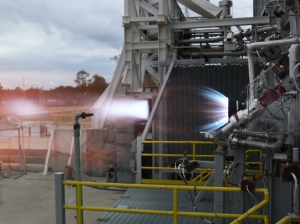Blue Origin Completes Engine Test
In a joint press release, NASA and Blue Origin announced that the company has completed an engine test as part of its CCDev-2 requirements. The engine, designated the BE-3, generates 100,000 lb thrust and is powered by liquid oxygen and liquid hydrogen. The test was conducted at NASA’s Stennis facility near Bay St. Louis Mississippi.
Blue Origin has consistently been very guarded in the information it releases, so it is difficult to tell how far the company is along in the process of developing its planned two stage Reusable Booster System, which would presumably be powered by the BE-3. If the BE-3 were fully developed and deployed, it would fit in a size class between the RL-10 1 and the RS-68 among U.S. built cryogenic engines.
It is interesting to note that after participating in previous rounds of the Commercial Crew program, with development of a pusher abort system and a composite design for its bi-conic Space Vehicle, Blue Origin did not submit a proposal for the current round, CCDev-3 which was won by Boeing SpaceX and Sierra Nevada. Previous reports had suggested that the company would submit a proposal combining the 7 seat Space Vehicle and the Atlas V 402 being developed for the Boeing CST-100 capsule and the Sierra Nevada Dreamchaser spaceplane.
It seems likely that Blue Origin made good use of the opportunities opened by the Commercial Crew program and Space Act Agreements to advance the state of their technology without necessarily intending to proceed to full deployment at the pace being driven by the demands of the program. This is not necessarily a bad thing either for NASA, Blue Origin or advocates of full spacecraft re-usability. In pursuing a cryogenic system, Blue Origin has selected a more challenging design architecture than absolutely necessary, and one that may simply take some time to develop.
However, give the fact that NASA is responding to a nascent capability in reusable suborbital systems like that offered XCOR and others, the path of gradual evolution towards true re-usability seems a reasonable approach for a company which for the moment, prefers to remain very much in the shadows.


